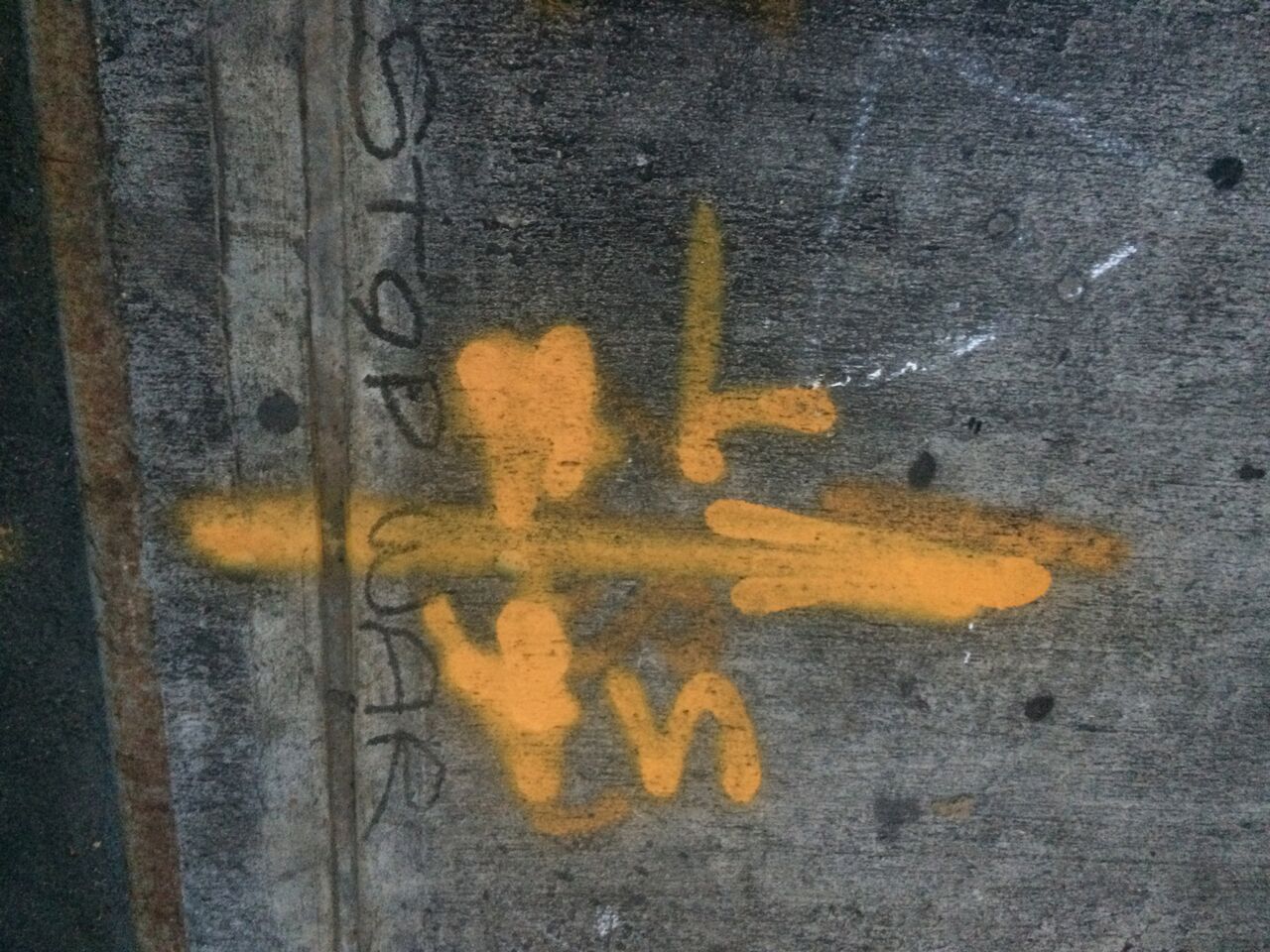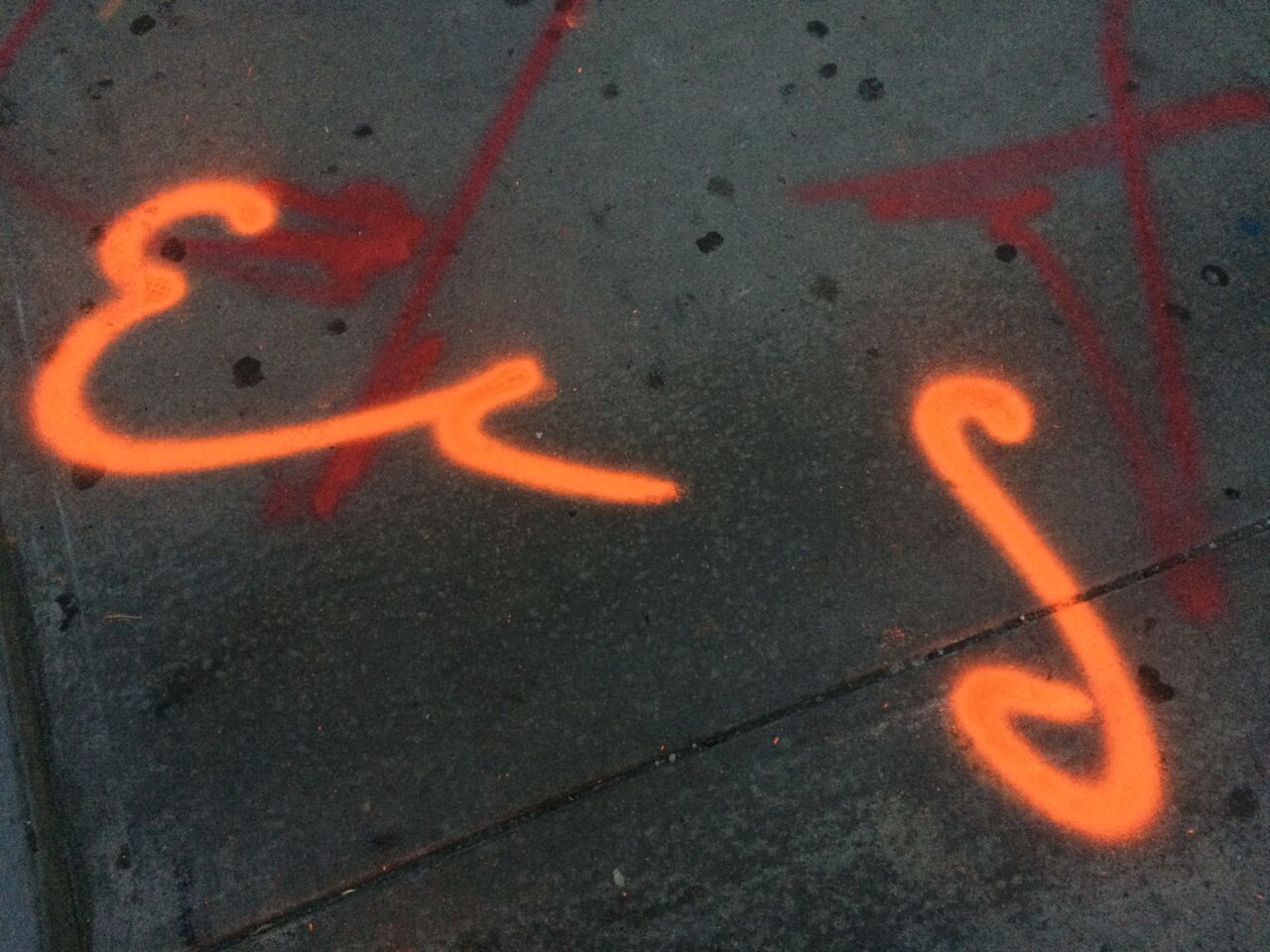
There he is, standing at the top of the subway stairs, the man with the paint-spattered boots. I’ve been searching for him for weeks, tracking his movements through the city. He is a member of a specialized platoon of six, but the only one trained to work at night. His special skill is decoding and signposting the hidden world under our feet, the substratum of fiber optics, electricity cables, water lines, and steam ducts that roil under the sidewalks of New York City.
He holds a half dozen maps, the earliest dating to the late nineteenth century, the most recent updated just a few months ago. They are a historical-geographical cross-section of this exact spot. The maps depict the width and depth of water pipes, telephone wiring, and steam ducts that have lain buried here for over a century. His job is to decode these maps, and mark the sidewalk with lines and letters, alerting the advancing excavation crews of what lies beneath.
We’re standing on the corner of Edgar Street and Trinity Place. For weeks I’ve kept tabs on a dense hieroglyphics mysteriously taking shape. A manhole has sprouted a nimbus of red lines and the curb has been tattooed with yellow hash marks.
He consults his maps. In one agile stroke sweep he makes two long lines with his paint wheelie, swirls and spins, and spells out ECS on the sidewalk. ECS stands for Empire City Subway, a company that has maintained our communication infrastructure since 1891 (they are now owned by Verizon). If he makes a mistake, and an excavation crew misjudges their trench by just a few inches, then mainframe computers and landlines and cable hook-ups on this edge of Wall Street will crash. He has to know his stuff.

Our vital information infrastructure is only pavement deep: as shallow as three feet under the pavement. Just follow the orange lines and you can trace how future cabling will branch from a major road conduit into an office or a building, making the hidden visible. These lines, says Brett Littman, of the Drawing Center "can be read as a palimpsest of the city, having meaning, like graffiti, even though the intention is not artistic."
In addition to orange, there are two colors of this sidewalk tagging that suggest more imminent threats: yellow (for gas and steam lines) and red (for electrical cables). A former Con Ed spokesman, Chris Olert, calls these spray painted lines by their working name, mark-outs, and says that they are vital to the safety of the city. “You don’t want a backhoe hitting a 38,000-watt cable.” Before an excavation crew digs through the surface of the street they are legally bound to call a designated phone number which then coordinates with the utility companies to send out their mark-out crews, called locators, who mark out the utility lines and thereby delineate the spots where it’s safe to drill. It’s the equivalent of a human stud finding system.
Mark out lines are “a language, a code to decipher,” says urban archeologist Alyssa Loorya, and they help alert her to where an excavation is going to take place. There were no such lines in Los Angeles in 1976, when the Culver City explosion took place. But three months after that blast, a one-call system, similar to Kleinberg’s, called “DigAlert,” was authorized.
It was in 1976 that James Attebery, the city engineer of Phoenix, Arizona, received an auspicious phone call. It was from the city engineer in Albuquerque. Color tagging for the various utilities hadn’t yet been standardized nationally and since Attebery was the chairman of a national committee that oversaw utility location coordination (the ULCC) he thought Attebery would know what the approximate code might be.
Attebery was an expert on this kind of thing; he had already standardized a system for locating utilities underground, but to Attebery’s astonishment he couldn’t find a color-coding standard. He got on the phone to David Punches from AT&T who oversaw the local ULCC committee on markings. “I met with David on this, and he wisely recommended keeping it simple. He suggested one [color] for each utility.” Attebery hadn’t heard about the California explosion, but he speculates that the federal agency in charge of pipeline safety, which had taken a keen interest in the utility council, probably had. In 1976 the system was adopted, officially approved in 1980, and it is now the basis for the color-coding mark out system we use today.

The nameless Verizon worker rests his paint wheelie on the ground while we chat. He doesn’t seem to be in a hurry. The light is falling and he has six more hours on the job. His orange luminescent vest identifies him as an authority and tourists politely approach him asking for directions to the 9/11 memorial. He obliges with astonishingly accurate directions, almost down the exact number of yards: the street is his domain.
He can’t be more than twenty-five. He admires the previous generation of communication workers. Before he landed his current job he wired telephone lines. He loved being sent to Harlem to work on the brownstones that hadn’t been gentrified yet. In those buildings, he said, you could still see skilled wiring where the workers had a sense of craft, their wires beautifully bundled in tight sheaths wrapped in something that looked like cotton. Their lines were straight and true.
It’s dark now. I ask him for another mark-out demonstration. He checks his map, picks up his paint wheelie, and takes a graceful turn.
To read the entire article, buy a copy of Observer Quarterly 2 at Blurb.


Comments [2]
07.07.16
08:38
07.08.16
09:35